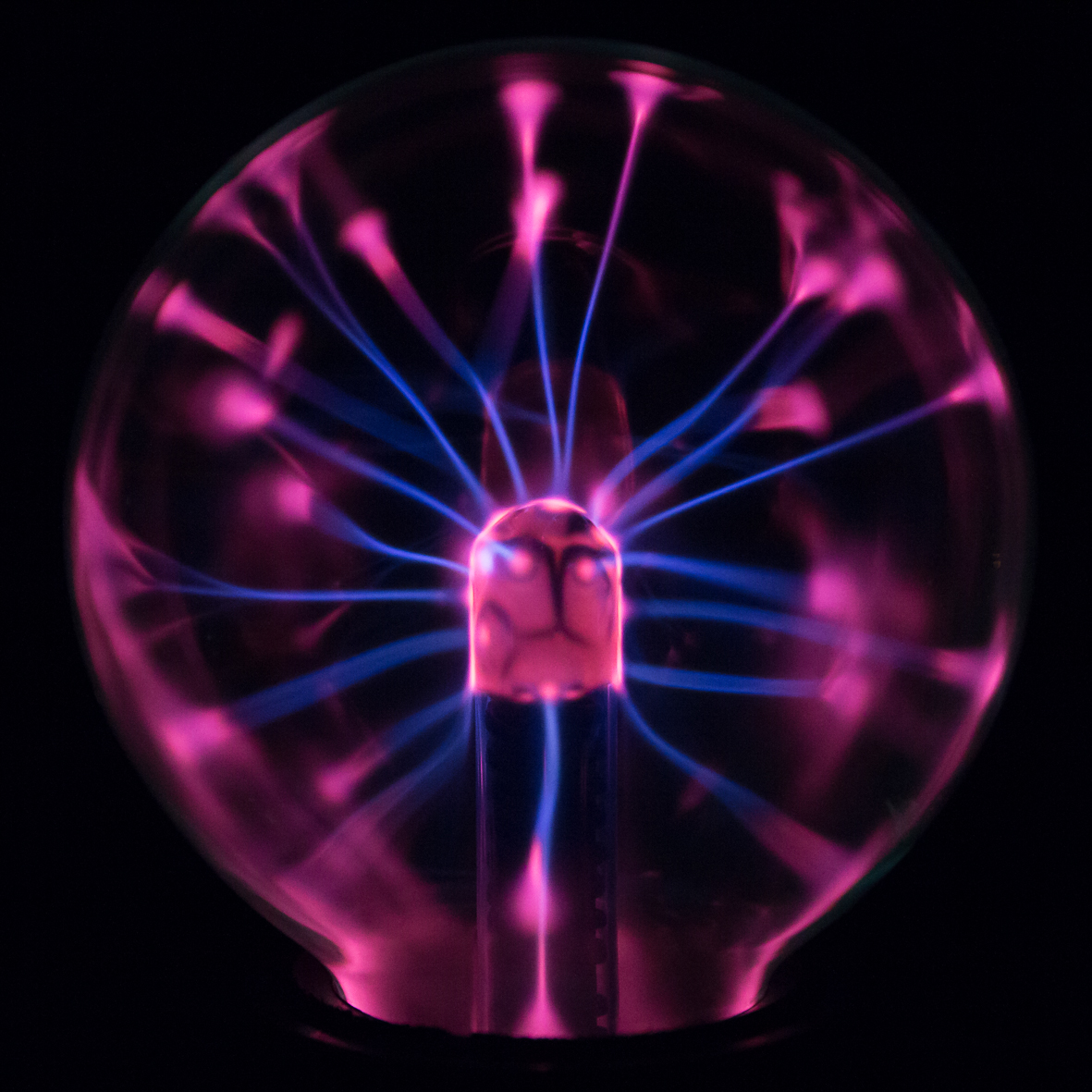The magical plasma globe is well known—it used to be a popular decoration at parties and clubs. At first glance it seems like a simple device, yet the spectacular light effects are based on quite a complex phenomenon. You can also perform some interesting experiments with it to surprise your friends.
The gadget known as a “plasma globe,” evoking the disco mood of the 1980s, doesn’t emit much light, but the bright, thread-like lightning bolts dancing inside the sphere always draw attention. Thanks to the inexhaustible gadget-making capacity of Chinese industry, the device is available today in many variations. The price of 10 cm globes powered by USB ports ranges from €6 to €10. The larger 15–20 cm globes with their own power supply are sold for €8–20, and almost without exception these include a built-in microphone, allowing the globe to be sound-controlled.
One such toy came to me for repair, so I started by taking it apart. Do not try this at home! Inside the box you find very primitive electronics. An integrated circuit generates oscillations at 15–45 kHz (square wave), which drives a power transistor mounted on the large black heatsink. The microphone is also mounted on the board, connected to a transistor amplifier that provides the sound control.
The high voltage required for the operation of the plasma globe is produced by a transformer—similar to the ones used in old CRT televisions. With a supply voltage of 12 V, the power transistor feeds the transformer with current pulses peaking at about one ampere. At the output, the transformer induces a voltage of 15–25 kV, which is then delivered to the globe.
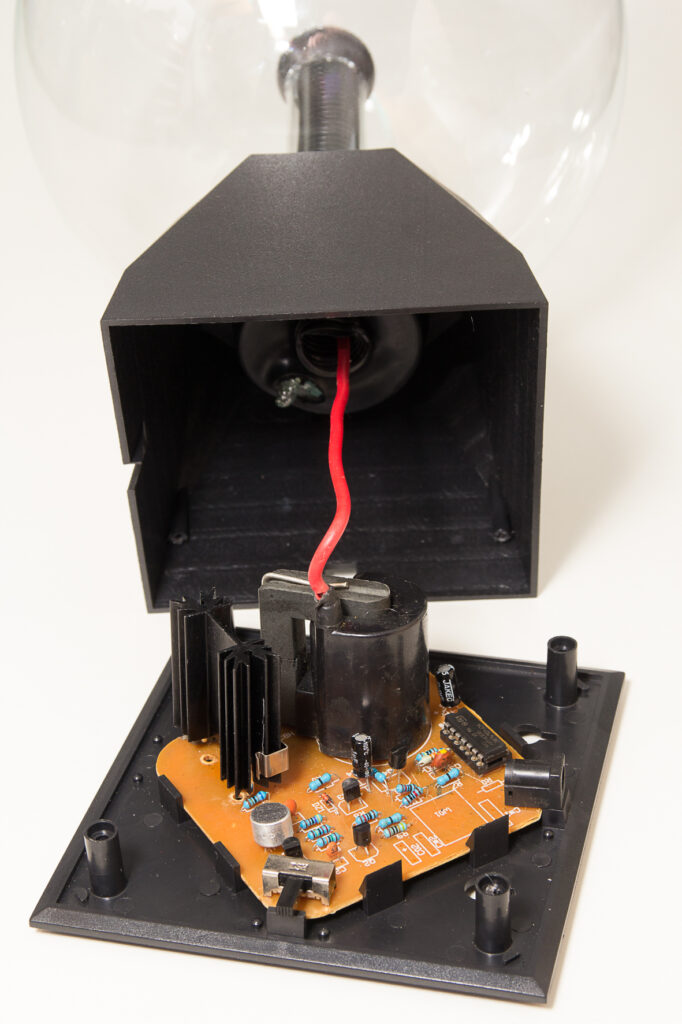
Inside the globe there is usually low-pressure air (500–600 mbar), which glows pale pink. Some manufacturers use a mixture of gases to achieve a more spectacular effect. Neon gives a more intense orange glow, argon bluish-violet, helium yellowish-white, krypton white, and xenon bluish-white.
Unfortunately, plasma globes deteriorate over time even if they are not used. The reason is that the gases gradually diffuse through the thin glass wall. The plasma globe is not sensitive to the magnitude of the voltage or the frequency (it doesn’t need to be “tuned to resonance” like a Tesla coil), but it is highly sensitive to the composition and pressure of the filling gas—which eventually leaks away through diffusion. Even the most carefully sealed glass bulb is not gas-tight: noble gases can pass through solid glass itself!
This is also why our globe failed. The electronics were intact, but the globe produced only a few-centimeter-long light streak. Such a plasma globe can be made to work temporarily by increasing the supply voltage. I fitted a larger heatsink to the power transistor to withstand the load, and raised the supply voltage from 12 V to 24 V. The experiments were carried out with this “revived” globe, though they can be performed with any “healthy” globe as well, yielding the same results. The only difference is that, because of the altered pressure, my globe produces thicker, more stable discharge beams instead of thin filaments—less spectacular in appearance.
Electricity Flows Through Your Hand
In the center of the glass sphere there is a small glass bulb, the inside of which is coated with graphite to make it electrically conductive. As can be clearly seen in the picture, a thick red wire connects this to the high-voltage output of the transformer. In fact, the graphite is on the outside of this inner bulb, so no metal electrode has to be introduced into the gas space. The little sphere acts as a capacitor: current is coupled capacitively through the glass into the gas chamber. The electric field around the bulb ionizes the gas particles, creating a plasma state. Plasma conducts current well, which then flows toward the outer globe. The plasma discharges are pulled into filaments by the magnetic field, and these sway because of the gas flow.
The outer globe has no conductive coating—it is simply an ordinary glass balloon, which also behaves like a capacitor. Its “outer electrode” is the surrounding air. Since the air has high resistance, the current remains weak.
Our body conducts electricity much better than air. When we touch the globe, the external field becomes distorted and the surface potential changes, causing the filaments to crowd toward the point of contact. The resistance drops, the current increases, and the discharge grows brighter. If you place your whole palm on the top of the globe, the current often condenses into a single bright filament so strong that its heat effect cannot be endured for long.
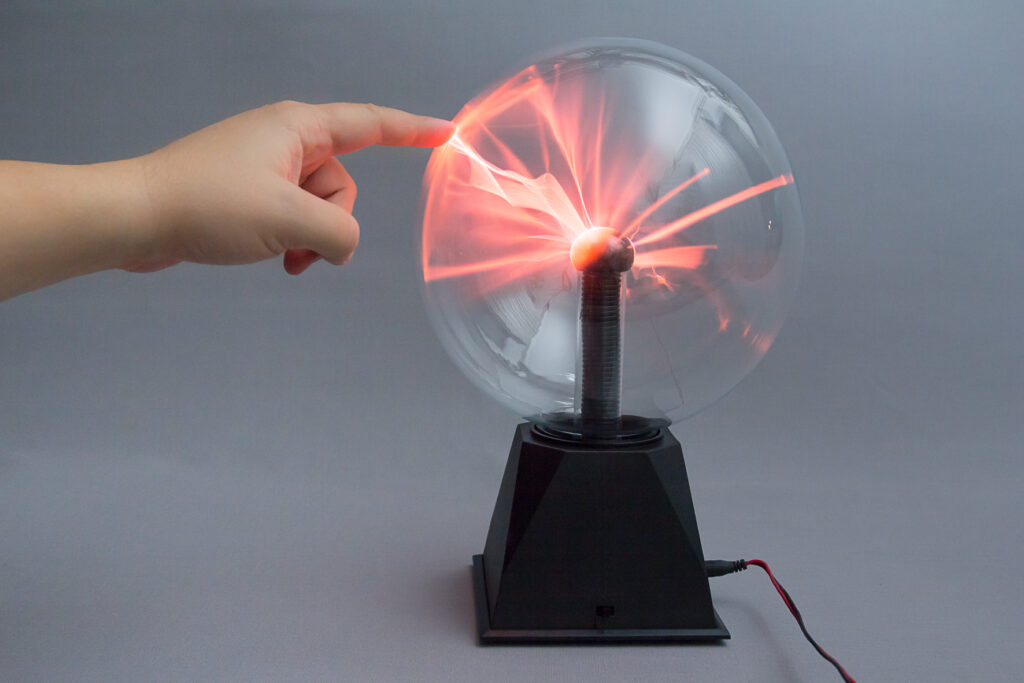
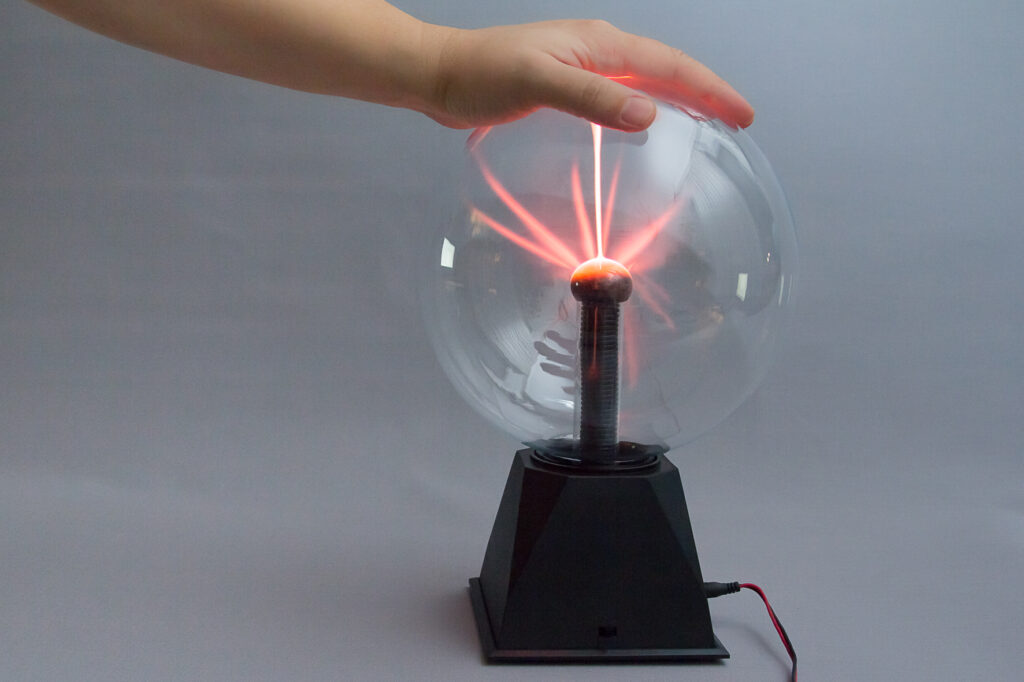
Current Unaffected by a Magnet
At school we are taught that a conductor carrying current experiences a force in a magnetic field. Based on this, we might expect the magnetic field to deflect the discharge filaments. Arc-blowing magnets used in high-power relays and high-voltage switches in transmission lines also extinguish arc discharges on this principle.
So let’s take a strong neodymium magnet and hold it near the globe! There is no sign of any magnetic effect. Why don’t the filaments twist away? The answer is simple: the current here is not direct current, but relatively high-frequency alternating current (15–45 kHz). The magnetic field acts on it as well, but since the direction of force changes rapidly with the alternating current, the filaments have no time to follow.
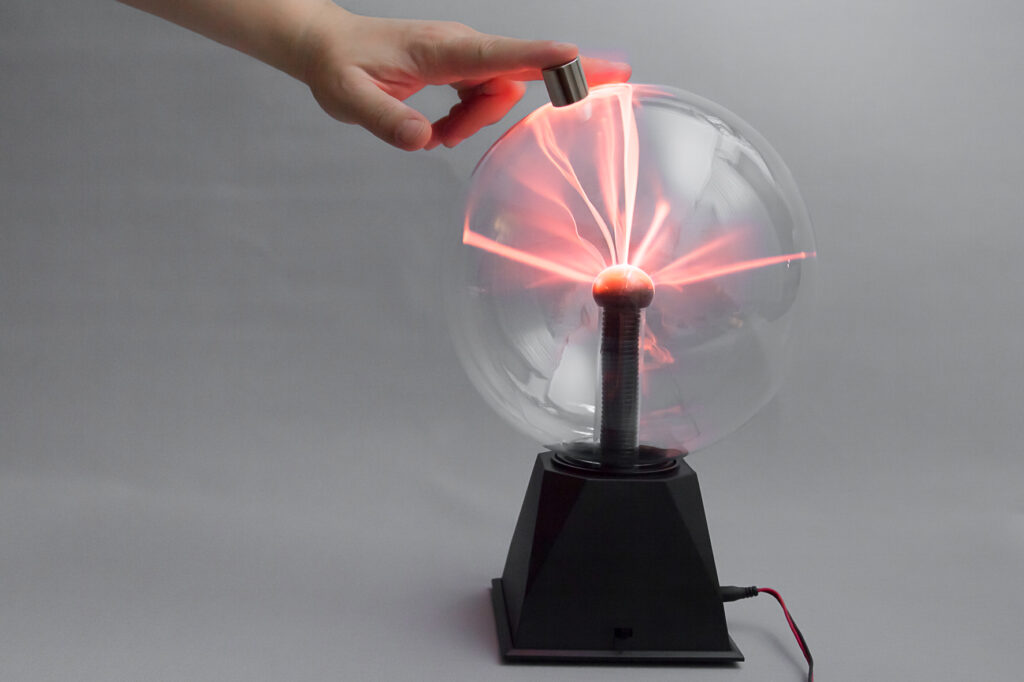
Skin Effect
When we place our palm on the globe, the current reaches a few milliamperes—enough for a person to feel it, sometimes even causing slight muscle twitches. It is easy to demonstrate that this current truly flows through our body. Take a light-emitting diode (LED) and hold one of its leads in your hand. When you touch the other lead to the globe, the LED lights up (see Fig. 6), which means current is flowing—several milliamperes, in fact!
Moreover, the LED glows faintly even when it is only brought close to the globe, showing that energy also propagates through the air. The effect is even more spectacular if two people hold the LED, one gripping one lead, the other the opposite lead. When one of them places a palm on the globe, the LED lights up between their hands! The current path then runs from the globe, through the first person, through the LED, and finally through the second person.

But why doesn’t the current give us a shock? High-frequency current, under the influence of its own magnetic field, does not flow through the full cross-section of a conductor (in this case, our body) but only along its outer surface. The higher the frequency, the less deeply the current penetrates into the conductor. At the plasma globe’s frequency of several tens of kilohertz, the penetration depth is only a fraction of a millimeter. That means the current bypasses not only the vital organs, but even the nerve endings beneath the skin. We don’t feel it at all!
There’s another way to demonstrate the current. Place a larger metal object (such as a bottle cap or a piece of aluminum foil) on top of the globe. Now take another metal object (say a knitting needle or a knife) and bring its tip close to the one resting on the globe. Sparks a few millimeters long leap from the tip! The arc is strong enough to burn right through a business card—but be careful: during this experiment the glass globe heats up and can crack!
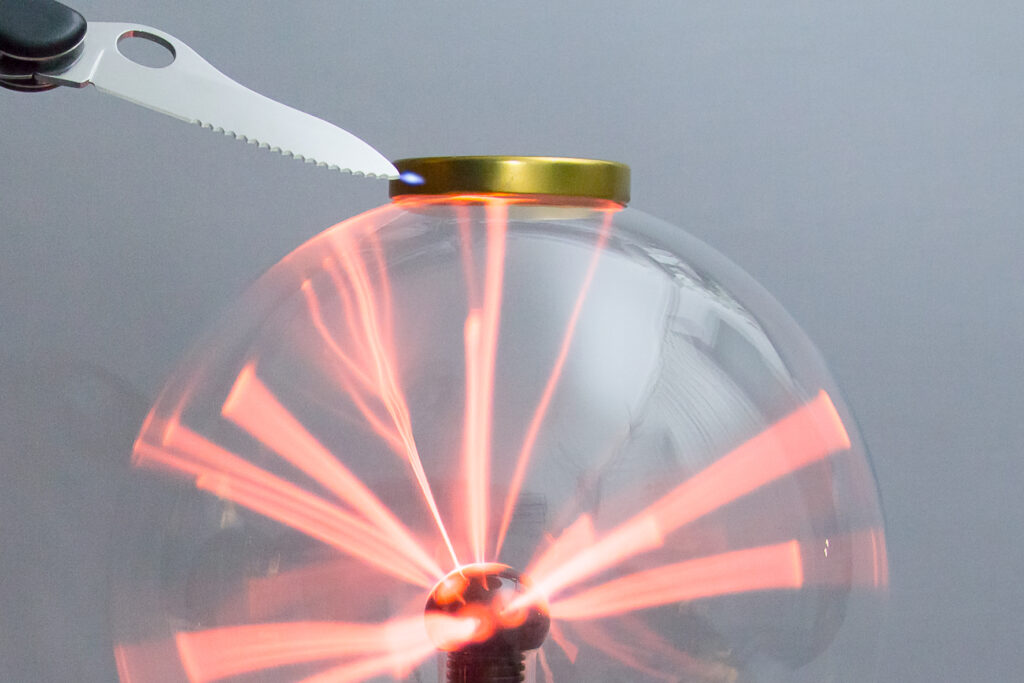
Gas Discharge in Other Gases
Can the globe’s field ionize other gases as well? Yes, it can. If you hold a gas-discharge device—such as a fluorescent tube, fog lamp, glow lamp, neon indicator, or even a Nixie tube—in your hand, the high-frequency field will ionize the rarefied gas inside. The gas becomes conductive, current begins to flow, and the tube lights up.
Even quite long tubes, up to 1–1.5 meters, can be made to glow this way—including “burnt-out” ones. It’s interesting to observe that the tube only lights up in the section between the globe and your hand. At the point where you are holding it, the current passes into your hand, completing the circuit through your body, and the rest of the tube stays dark.
The same effect can be seen in the glow lamps built into illuminated switches on extension cords and power strips: near the plasma globe, they light up as if they were actually switched on.
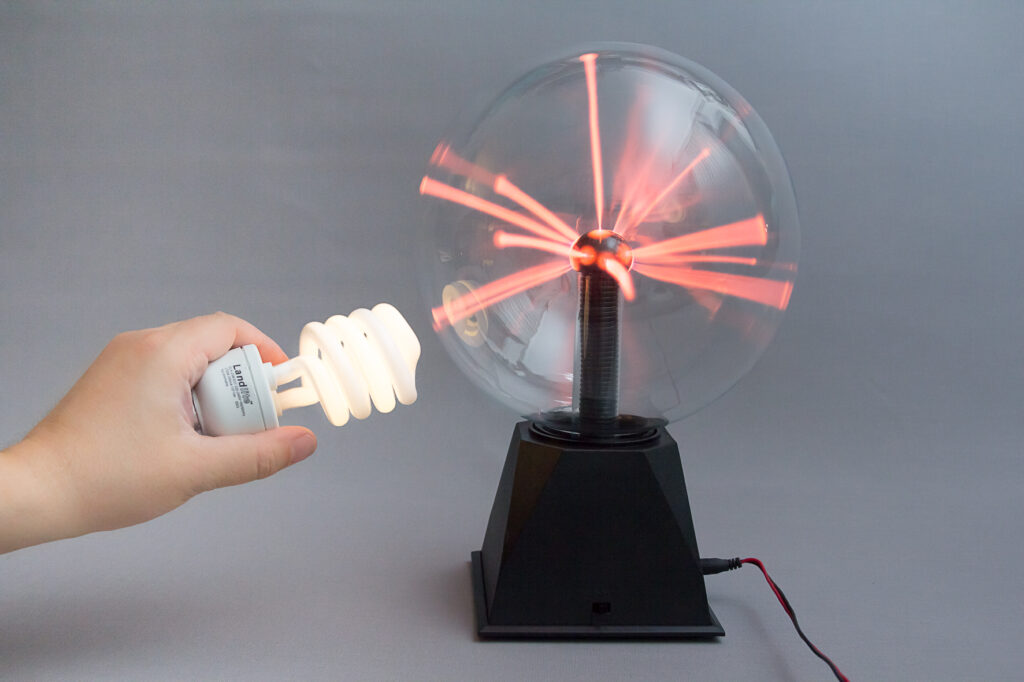
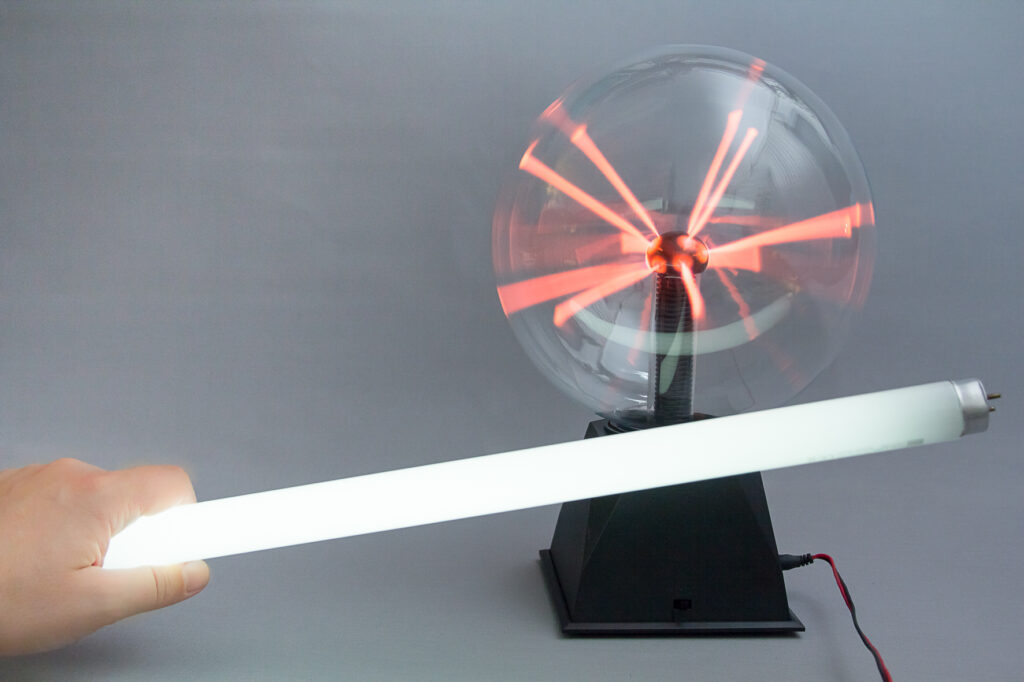
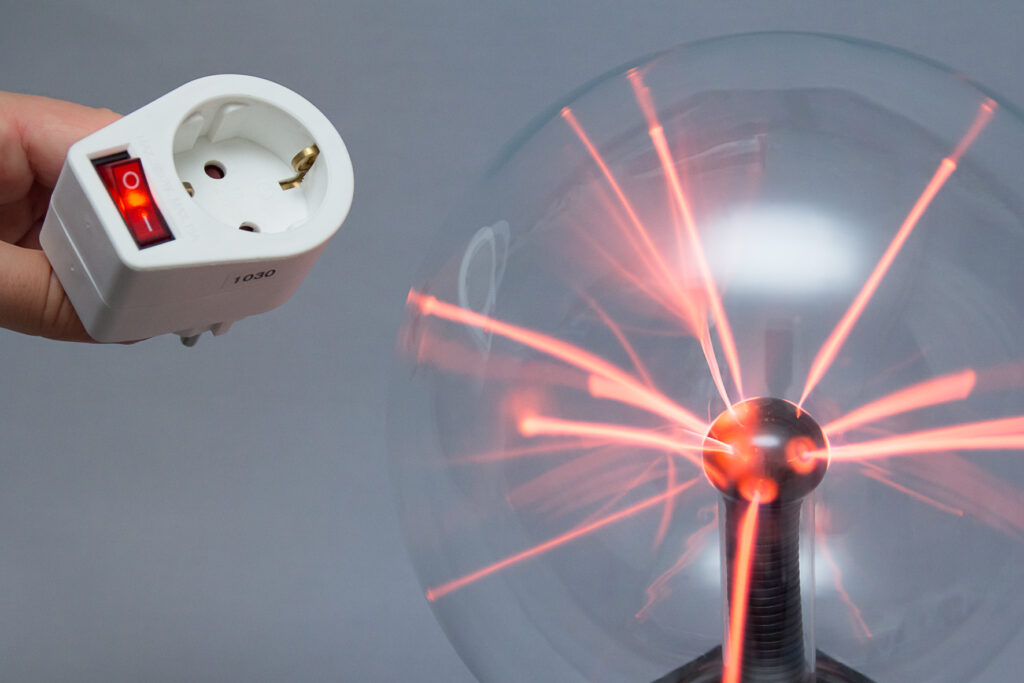
Let’s Jam the Radio
The globe generates an alternating electromagnetic field around itself. Even from a distance of one or two meters, the harmonics of its oscillation can be picked up by a radio receiver across the entire broadcast band. The globe causes the strongest interference in the longwave and mediumwave bands, where it blankets the spectrum with continuous static noise.
If the globe has acoustic control, you can even make it oscillate with the help of a radio receiver. Place the radio near the globe and point its loudspeaker toward it. When you tap the globe, the microphone switches on for a moment and the plasma flashes. The discharge creates electromagnetic interference that the radio picks up. The sound coming from the loudspeaker then triggers the plasma globe again, and the process repeats. The radio breaks into a deafening buzz, while the globe bursts into continuous flickering.

